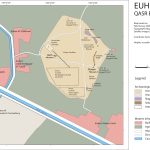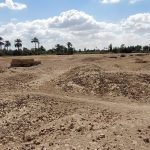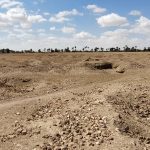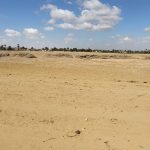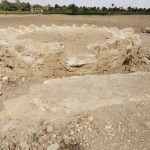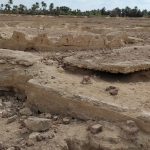QAṢR AL-BANĀT (EUHEMERIA)
| Greek | Εὐημερία |
| Arabic | قصر البنات |
| English | Euhemeria | Euhemereia | Euhemeris | Qasr el-Banat | Ezbet Afifi |
| DEChriM ID | 61 |
| Trismegistos GeoID | 675 |
| Pleiades ID | 736909 | PAThs ID | - |
| Ancient name | Euhemeria |
| Modern name | Qaṣr al-Banāt |
| Latitude | 29.373690 |
| Longitude | 30.543329 |
| Date from | -243 |
| Date to | 363 |
| Typology | Village |
| Dating criteria | Papyrological (about 400 papyri mostly in Greek but also Demotic), ostracological (over 100 ostraca in Greek), epigraphic (6 inscriptions) and numismatic evidence. The latter contains minted during the reign of Julian (360-363), which remains the latest securely dated artefact from the site (Römer 2019: 185-191). The earliest securely dated papyrus mentioning Euhemeria goes back to 243/242 BCE (P.Petr. III 82), while the latest exactly dated one dates from 347 CE (SB XXII 15728) (Römer 2019: 173). |
| Description | Euhemereia, modern-day Qaṣr al-Banāt, was a village located in the western area of the Fayyūm, 3.5km north-west of ancient Theadelpheia. Knowledge of the site is considerably sparse, with limited fieldwork ever having been conducted and that which was carried out being of poor quality and devoid of documentation. The village was inhabited from 260/259BCE until sometime in the fourth century CE, at which point it was abandoned, perhaps as a result of resource depletion. The identifiable structures at the site comprise a number of domestic buildings and a mud-brick temple to the north-west of the inhabited center. A necropolis is situated to the south and south-west of the site, separated from the village by a sandy depression, wherein five types of burial were identified (Davoli 1998: 295). All of the objects found herein seem to have been of Ptolemaic date (France 1999: 54). Most of that which is known derives from the textual sources retrieved from the site, including the archive of Lucius Bellenus Gemellus, as well as numerous other papyrological and ostracological documents. Greek and Demotic papyri were found in the aforementioned temple, with reference to Isis and Souchos (Sobek), the crocodile god, perhaps indicating that the temple was dedicated to them (Davoli 1998: 296). The site was likely home to a number of additional temple buildings, but this is the only one to have been identified archaeologically. A stela repurposed as a doorstep in one of the houses indicates the presence of a temple dedicated to Ammon, dating to the reign of Ptolemy 13th, while another stela attests to a third temple dedicated to crocodile gods Psosnaus, Pnepheros and Soxis (Hohlwein 1949: 65-67). The traces of Christianity at the site derive exclusively from textual sources, namely a letter (P.Fay. 136) and a contract (P.Mich inv. 401). As it stands today, most of the site has been leveled, and covered by modern agriculture, with limited structures identifiable on the surface. |
| Archaeological research | The archaeological work conducted on the site has been unfortunately sparse, basically limited to the explorations carried out by Grenfell and Hunt in the winter of 1888/1889. This work, which lasted for some six weeks, took place around the same time as that performed nearby at Theadelpheia. The men had visited the site three years prior, and, in the meantime, a land reclamation project had seen to the expansion of cultivated land, edging more than 1600 meters closer to the site. The quality of this fieldwork was poor, predominantly conducted with the intention of discovering papyri. Four weeks of work were dedicated to the southern and south-eastern part of the inhabited center, with the remaining two dedicated to the necropolis. The two accounts that resulted from this work were of limited scope and poor quality, with no information provided concerning stratigraphy, architectural layout of the houses, or even the general urban plan of the site (Grenfell and Hunt 1899: 8-10; Grenfell, Hunt and Hogarth 1900: 43-50, 61-62). The cemetery was explored briefly by Otto Rubensohn some three years after Grenfell and Hunt, as a secondary focus from his work in Theadelpheia. It is likely that the local inspectorate of the SCA carried out excavations, revealing a number of structures visible today, but there is no documentation or information available concerning such work (Davoli 1998: 297 n. 525). |
• Davoli, P. 1998. L?archeologia urbana nel Fayyum di eta? ellenistica e romana. 295-299. Napoli: G. Procaccini.
• France, J. 1999. "Theadelpheia and Euhemereia. Village History in Greco-Roman Egypt." PhD thesis, Katholieke Universiteit Leuven (Trismegistos Online Publications).
• Grenfell, B. P. and A. S. Hunt. 1899. "Graeco-Roman Branch: Excavations for Papyri in the Fayum; the Position of Lake Moeris." Archaeological Report (Egypt Exploration Fund) (1898-1899), 8-15.
• Grenfell, B. P., A. S. Hunt and D. G. Hogarth. 1900. Fayûm Towns and Their Papyri. London: Offices of the Egypt Exploration Fund.
• Hohlwein, N. 1949. “Euhéméria du Fayoum.” Journal of Juristic Papyrology 3: 63-99.
• Römer, C. 2019. The Fayoum Survey Project – The Themistou Meris Volume A – The Archaeological and Papyrological Survey, 173-210. Leuven: Peeters.
• Rubensohn, O. 1905. “Aus griechische-römischen Häusern des Fayum.” Jahrbuch des Deutschen Archäologischen Instituts 20: 47-48.


 Json data
Json data